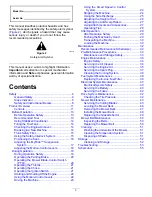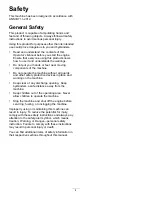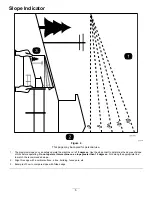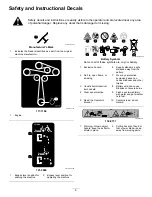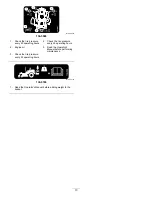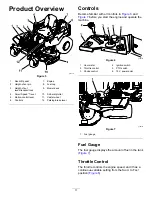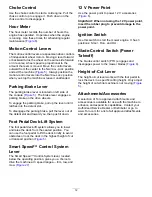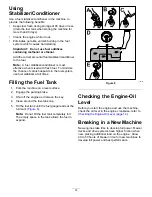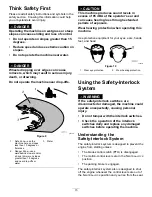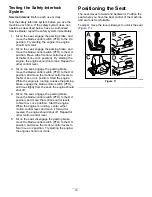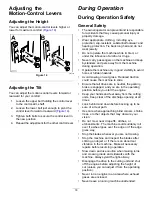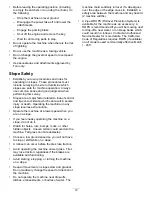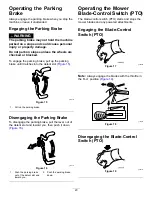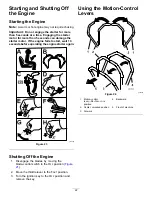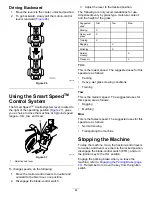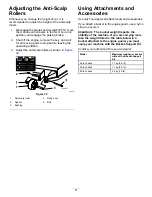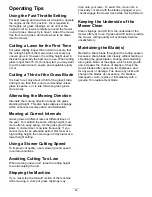
Operation
Note:
Determine the left and right sides of the
machine from the normal operating position.
Before Operation
Before Operation Safety
General Safety
•
Never allow children or untrained people to
operate or service the machine. Local regulations
may restrict the age of the operator. The owner
is responsible for training all operators and
mechanics.
•
Become familiar with the safe operation of the
equipment, operator controls, and safety signs.
•
Know how to stop the machine and shut off the
engine quickly.
•
Check that operator-presence controls, safety
switches, and shields are attached and functioning
properly. Do not operate the machine unless they
are functioning properly.
•
Before mowing, always inspect the machine to
ensure that the blades, blade bolts, and cutting
assemblies are in good working condition.
Replace worn or damaged blades and bolts in sets
to preserve balance.
•
Inspect the area where you will use the machine
and remove all objects that the machine could
throw.
•
Evaluate the terrain to determine the appropriate
equipment and any attachments or accessories
required to operate the machine properly and
safely.
Fuel Safety
•
To avoid personal injury or property damage, use
extreme care in handling fuel. Fuel vapors are
flammable and explosive.
•
Extinguish all cigarettes, cigars, pipes, and other
sources of ignition.
•
Use only an approved fuel container.
•
Do not remove the fuel cap or add fuel to the fuel
tank while the engine is running or while hot.
•
Do not refuel the machine indoors.
•
Do not store the machine or fuel container where
there is an open flame, spark, or pilot light, such
as on a water heater or on other appliances.
•
Do not fill containers inside a vehicle or on a truck
or trailer bed with a plastic liner. Always place
containers on the ground, away from your vehicle
before filling.
•
Remove the equipment from the truck or trailer
and refuel it while it is on the ground. If this is not
possible, then refuel from a portable container
rather than a fuel-dispenser nozzle.
•
Do not operate the machine without the entire
exhaust system in place and in proper working
condition.
•
Keep the fuel-dispenser nozzle in contact with
the rim of the fuel tank or container opening at
all times until fueling is complete. Do not use a
nozzle lock-open device.
•
If you spill fuel on your clothing, change your
clothing immediately. Wipe up any fuel that spills.
•
Never overfill the fuel tank. Replace the fuel cap
and tighten it securely.
•
Store fuel in an approved container and keep it
out of the reach of children. Never buy more than
a 30-day supply of fuel.
•
Do not fill the fuel tank completely full. Add fuel to
the fuel tank until the level is 6 to 13 mm (1/4 to
1/2 inch) below the bottom of the filler neck. This
empty space in the tank allows fuel to expand.
– Avoid prolonged breathing of vapors.
– Keep your face away from the nozzle and fuel
tank opening.
– Avoid contact with skin; wash off spills with
soap and water.
Recommended Fuel
•
For best results, use only clean, fresh (less than
30 days old), unleaded gasoline with an octane
rating of 87 or higher ((R+M)/2 rating method).
•
Ethanol
: Gasoline with up to 10% ethanol
(gasohol) or 15% MTBE (methyl tertiary butyl
ether) by volume is acceptable. Ethanol and
MTBE are not the same. Gasoline with 15%
ethanol (E15) by volume is not approved for use.
Never use gasoline that contains more than
10% ethanol by volume
, such as E15 (contains
15% ethanol), E20 (contains 20% ethanol), or E85
(contains up to 85% ethanol). Using unapproved
gasoline may cause performance problems and/or
engine damage which may not be covered under
warranty.
•
Do not
use gasoline containing methanol.
•
Do not
store fuel either in the fuel tank or fuel
containers over the winter unless you use a fuel
stabilizer.
•
Do not
add oil to gasoline.
13



